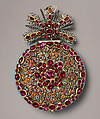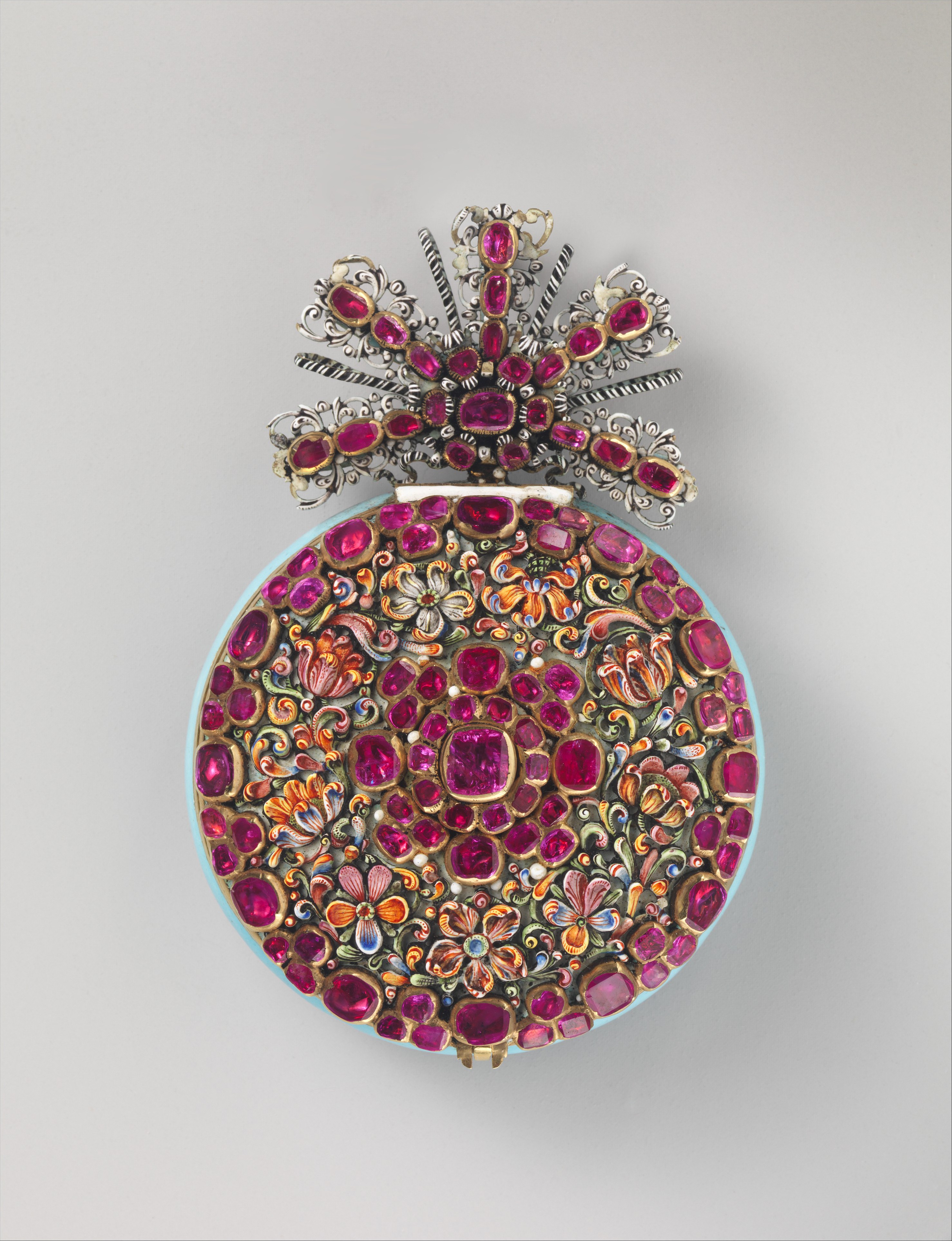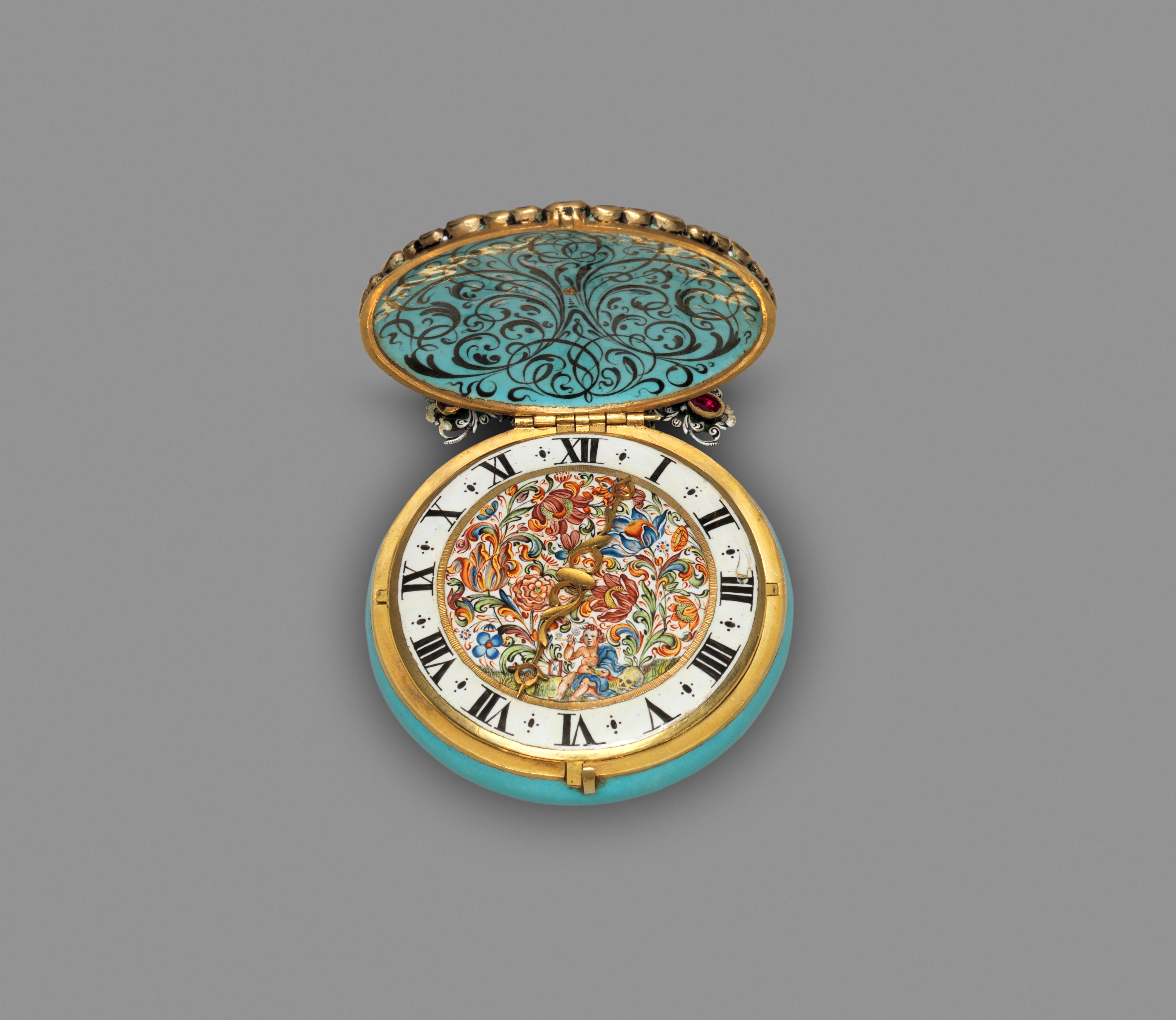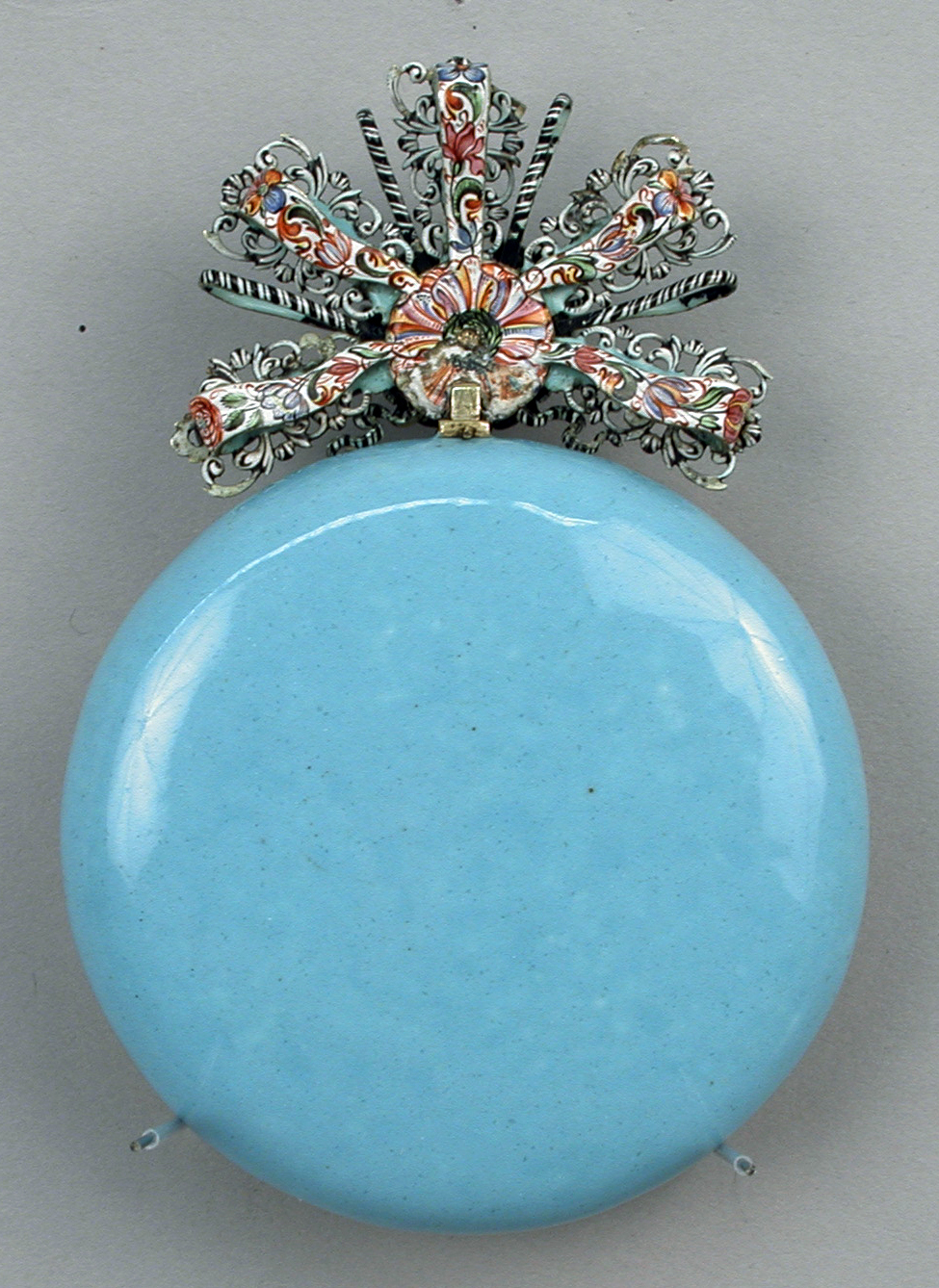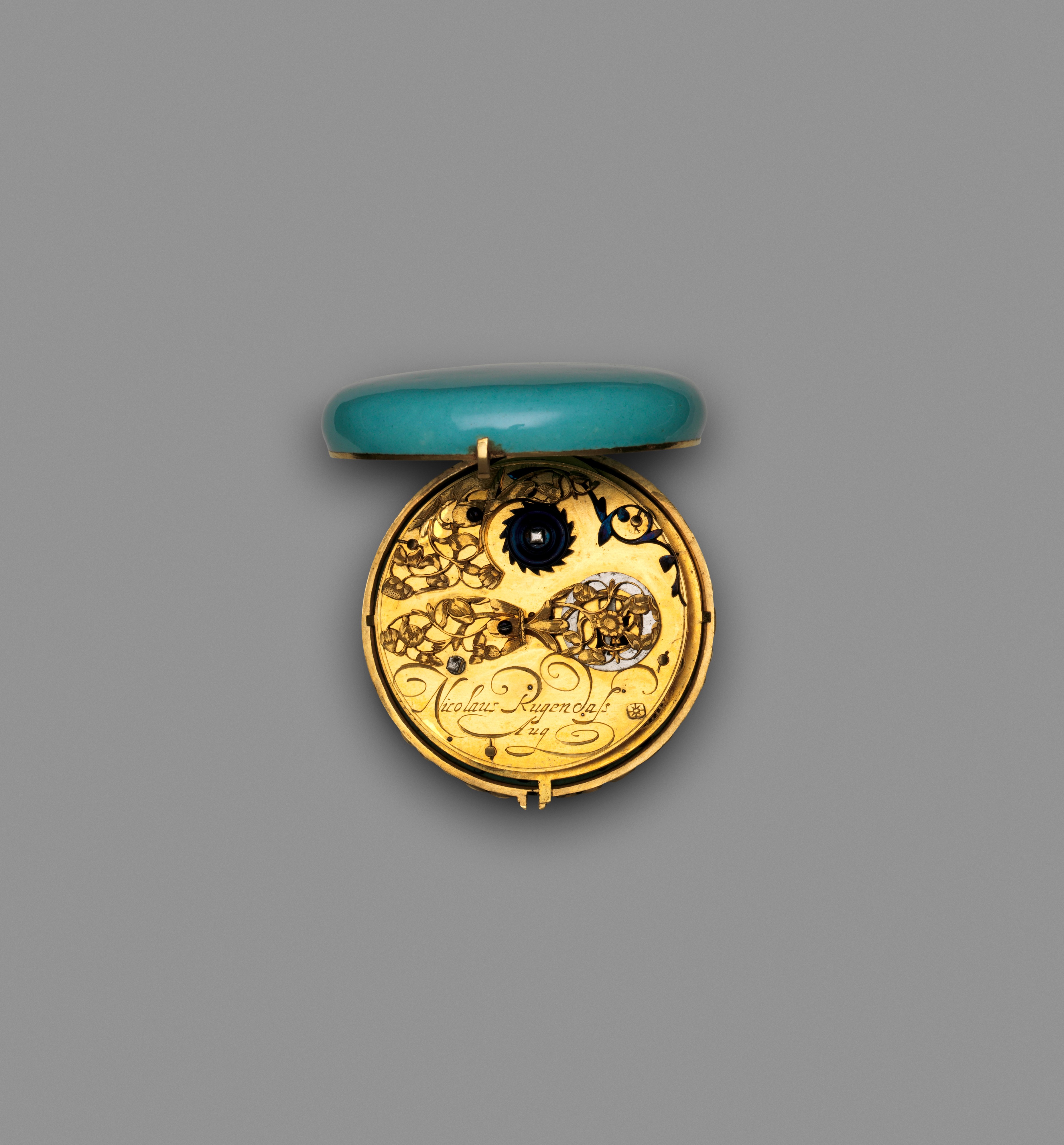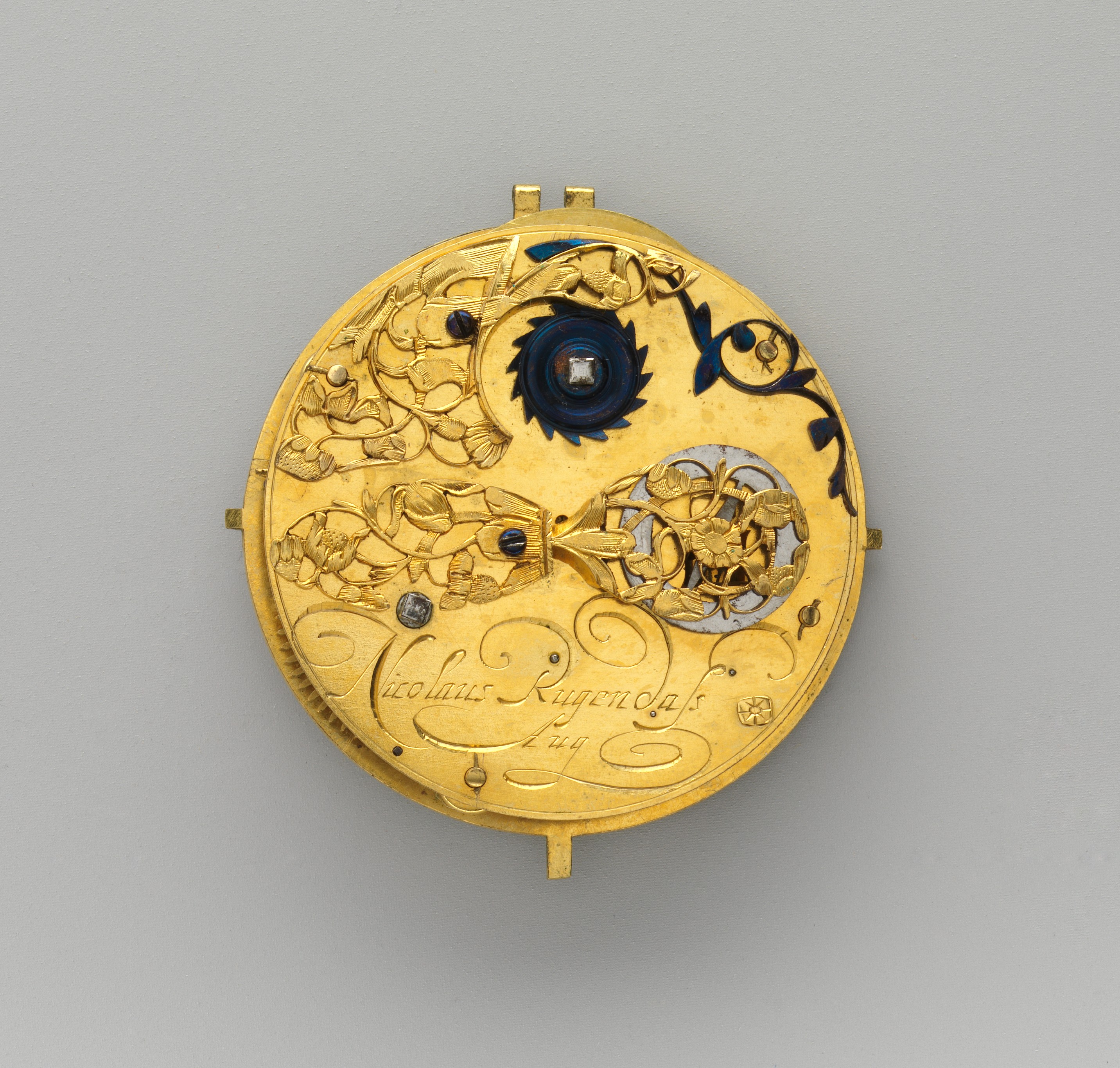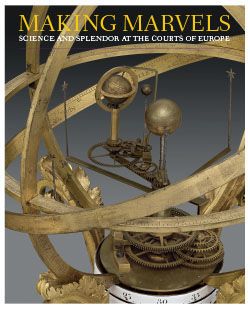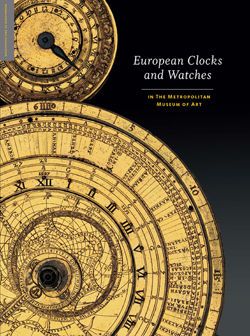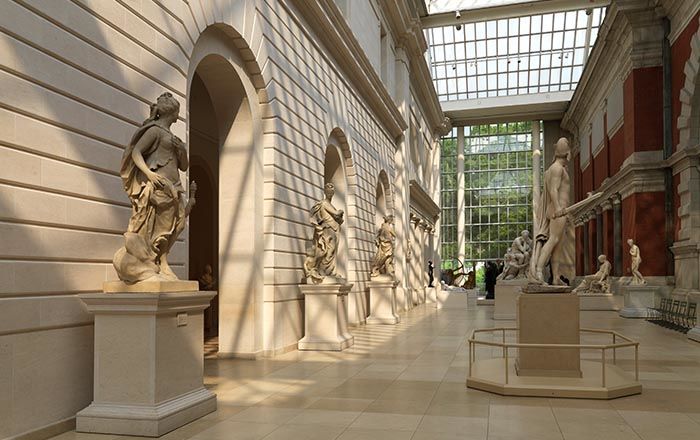Watch
Watchmaker: Nicolaus Rugendas the Younger German
Not on view
Until 1702 the Augsburg makers of small gold objects ornamented with enamel and often set with gemstones were craftsmen who belonged to the same guild as the makers of silverware.[1] As in most European centers of metalworking, objects of gold and silver were usually required to bear the punchmark of the town where they were made and the maker’s mark. Enameled gold objects, such as this watchcase, were usually exempt from the requirement owing to the danger of cracking the enamel. The maker of this watchcase thus remains anonymous. The cover of the case, however, displays a floral design that is typical of products made by South German goldsmiths from about 1660 to 1680.
This variety of dense ornament, which is arranged without an easily detected axis, has its sources in earlier printed designs for jewelry and watchcases as, for example, prints by the Swiss Claude Rivard (active 1623–70),[2] or the Frenchman Jacques Vauquer (1621–1686),[3] brother of the watchcase-enameler Robert Vauquer (1625–1670) who is acknowledged to have been one of the best in Blois. Jacques worked for a time as an engraver for Jean-Baptiste Monnoyer (1636–1699), a flower painter and favorite of the French royal court. On his own, Jacques published designs for watchcases and for watch cocks, some not unlike the openwork cock of the Museum’s Rugendas watch. The enameled pendant of the watch, shaped like a twice-tied bow, is only a little less extravagant than designs by another Frenchman and court jeweler, Gilles Légaré (1617–1663), whose Livre des ouvrages d’orfevrerie fait par Gilles Legare orfevre du Roy appeared in 1663 and in four subsequent editions.[4] As the title page for the series of prints indicates, Légaré was goldsmith to King Louis XIV (1638–1715) and therefore played a major role in setting fashion in French jewelry.
But closer to Augsburg, a comparable style of dense floral ornament appeared in prints made by Johann Wilhelm Heel (1637–1709). Born in Augsburg, Heel settled in Nürnberg, where he produced several series of engraved designs beginning in 1664, including six series titled Schneid-Buchlein, published by David Fünck (1642–1705) in Nürnberg.[5] One of these, probably intended as a design for a watchcase, displays a large flower in the center of a dense, circular floral design (fig. 30). The Museum’s watchcase has a similar floral design, except that a splashy cluster of twenty-six rubies instead of a flower occupies the center. Heel’s design includes an elaborate foliate pendant that is set with a jewel in the center,[6] but the bowknot-shaped pendant on the Museum’s watchcase relates more closely to Légaré’s designs.
The maker enameled the cover of the Museum’s watchcase with an openwork design over a gold ground in low relief, adding a circular border of forty-seven rubies that are organized in a repeating pattern of one large stone, three small stones. The pendant is set with another twenty-two gems completing the design. The case is enameled, inside and out, in a shade of pale blue that was much favored by seventeenth-century Augsburg enamelers. When open, the inside of the cover reveals more of the same shade of blue but overlaid with a playful design of scrolls painted in black.
The dial of the watch contains yet another enamel with the center painted in natural colors in an allover floral design. At the bottom, in the six o’clock position, an infant personification of Time sits between a sandglass and a human skull as a reminder that life is fleeting. A single ornamented hand indicates the time. The pure-white enamel chapter ring registers only hours (I–XII) and half hours. Quarter hours may be estimated, but in sum, the watch was intended to be as much a piece of jewelry as a serious timekeeper.
The pre–balance spring movement is a finely finished but otherwise unremarkable product from a member of a prominent family of clockmakers, three of whom were named Nicolaus (or Nikolaus) Rugendas. The first Nicolaus (1585–1658) came from the Hessian town of Melsungen, worked for a time in Regensburg, and moved to Augsburg in 1608.[7] His son, Nicolaus II (1619–1694/95), was born in Augsburg and became a master clockmaker there by inheritance in 1662.[8] His status as the son of a master clockmaker would have carried with it advantages that would not otherwise be granted to aspiring clockmakers in the city. Nicolaus III (1665–1745), the son of Nicolaus II, became a master clockmaker by inheritance in 1669, but he is best known not for clocks or watches but for portable sundials.[9]
Not many timepieces that were housed in cases made of precious metals and set with gemstones have survived, subject as they are to destruction owing to the intrinsic value of their materials, as well as to changes in fashion. It is, therefore, difficult to know whether Nicolaus II Rugendas may have specialized in supplying movements for opulent cases, but a clock with a movement signed “Nicolaus Rugendas Aug” in a gilded-silver case and enriched with garnets, amethysts, hyacinths, peridots, and turquoises can be found in the collection of the Wittelsbach Electors of Bavaria preserved in the Schatzkammer der Residenz in Munich.[10]
Like most seventeenth-century watches in the Metropolitan Museum’s collection, this watch was the gift of J. Pierpont Morgan. In Morgan’s collection catalogue published in 1912, it is called the “Great Ruby Watch” and documented as coming from the collection of Baroness Alphonse de Rothschild (Leonora von Rothschild, 1837–1911).[11] Previously, the watch had been in the possession of Charles Mannheim.[12]
Notes (For key to shortened references see bibliography in Vincent and Leopold, European Clocks and Watches in the Metropolitan Museum of Art. NY: The Metropolitan Museum of Art, 2015)
[1] Weinhold 2000, p. 44 and n. 6.
[2] See Fuhring and Bimbenet-Privat 2002, pp. 144–58, especially the medallion, or watchcase, in no. 382.
[3] For a selection of Vauquer’s engravings, see Tardy 1971–72, vol. 2, pp. 634–36.
[4] Bimbenet-Privat 2002, vol. 1, p. 396, and vol. 2, p. 467.
[5] Hollstein, German, 1954–2014, vol. 13 (1984), pp. 88–89, no. 25.
[6] Ibid., p. 90, no. 28.
[7] Bobinger 1966, pp. 156–59, 291; Maurice 1976, vol. 1, p. 295, no. 167b.
[8] Bobinger 1966, pp. 159 and 291, where the author’s description of the Museum’s watch is not accurate. See also Maurice 1976, vol. 1, p. 296, no. 215a.
[9] Bobinger 1966, pp. 158–62, 292–98. See also Maurice 1976, vol. 1, p. 297, no. 259a.
[10] Thoma and Brunner 1964, p. 286, no. 723, where it is dated about 1660 and cited as the clock in an inventory of the collection made in 1730.
[11] Williamson 1912, p. 102, no. 95, and pl. xlv.
[12] Galerie Georges Petit 1910, p. 42, no. 114, ill.
This image cannot be enlarged, viewed at full screen, or downloaded.
This artwork is meant to be viewed from right to left. Scroll left to view more.
